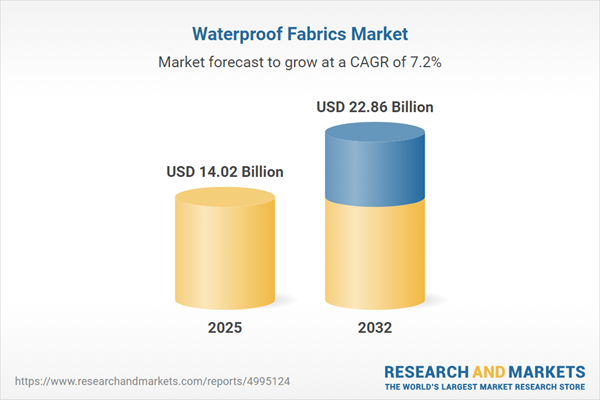Speak directly to the analyst to clarify any post sales queries you may have.
The waterproof fabrics market is undergoing significant transformation as sustainability, innovation, and dynamic supply chain requirements shape competitive strategies across global industries. Senior decision-makers must closely track technological advances and changing regulatory demands to stay ahead in this evolving landscape.
Market Snapshot: Waterproof Fabrics Market Growth and Opportunity
The Waterproof Fabrics Market expanded from USD 13.10 billion in 2024 to USD 14.02 billion in 2025, and is forecast to reach USD 22.86 billion by 2032, reflecting a CAGR of 7.20%. Growing adoption spans automotive, construction, marine, sportswear, and outdoor industries, revealing sustained demand for high-performance solutions. Increasing resilience requirements in response to climate volatility and regulatory complexity drive interest in advanced, durable materials. The market emphasizes durability, technical capability, and a rigorous focus on material lifecycle management, with stakeholders investing in value-added innovation to meet sector-specific needs.
Scope & Segmentation of the Waterproof Fabrics Market
This in-depth research is designed for leadership teams seeking actionable insights on market structure, enabling data-driven investment and operational planning. The comprehensive segmentation supports leaders in benchmarking and targeting emerging opportunities:
- Material Types: Polyurethane, PTFE, PVC, and TPU each present unique trade-offs in durability, flexibility, environmental compatibility, and versatility across applications.
- Technology Types: Hydrophilic and hydrophobic coatings, microporous barriers, and nanotechnology-based solutions support innovations in water resistance, breathability, and sustainability.
- End Uses: Applications span automotive interiors and exteriors, construction materials such as building facades and roofing, technical footwear, marine coverings, outdoor apparel, and sportswear serving both commercial and performance needs.
- Distribution Channels: B2B networks remain primary for infrastructure and OEM demand; digital and e-commerce channels are gaining ground, especially where customization or rapid response is essential.
- Regions: The analysis includes Americas, Europe, Middle East, Africa, and Asia-Pacific, with detailed insights for North America (United States, Canada, Mexico), Latin America (including Brazil, Argentina), Western and Eastern Europe, the Middle East and Israel, key economies in Africa, and a diverse range of Asia-Pacific markets.
- Key Companies: The study tracks W. L. Gore & Associates, Toray Industries, Nitto Denko Corporation, 3M Company, Milliken & Company, Huntsman International, Trelleborg AB, Sympatex Technologies, Schoeller Textil AG, and Colbond Limited, all leading the development and supply of waterproof fabrics worldwide.
Key Takeaways for Senior Decision-Makers
- Emerging materials science, including nanotechnology and microporous developments, is enabling an optimal balance of durability, breathability, and reduced environmental impact across product lines.
- Regulatory frameworks continue to tighten around chemicals and volatile organic compounds, accelerating investments in recyclable and environmentally responsible materials.
- Supply chains are evolving, with a marked shift toward nearshoring, new supplier partnerships, and alternative sourcing models to mitigate risks associated with tariffs and geopolitical events.
- Collaboration throughout the value chain—including resin producers, textile mills, and technology innovators—is fostering faster product launches and measurable sustainability outcomes.
- Manufacturers are leveraging refined segmentation and digital strategies to better address B2B client requirements and offer flexible solutions for niche and mass-market opportunities.
- Regional market dynamics are distinct: North America focuses on expanding production capacity; EMEA prioritizes compliance and technical benchmarks; Asia-Pacific drives investments in research and large-scale manufacturing.
Tariff Impact and Competitive Adjustments
Proposed United States tariffs on polymer imports are reshaping sourcing and production frameworks across the waterproof fabrics value chain. Companies are increasingly shifting critical manufacturing steps to regions with lower tariff exposure and strengthening collaboration with suppliers in Asia-Pacific and Latin America. These adjustments support agile supply chain management and strengthen resilience against ongoing trade volatility. The introduction of hybrid membranes and alternatives to conventional polymers is further enhancing market agility, with nearshoring and expanded North American capabilities emerging as core strategies for long-term competitiveness.
Methodology & Data Sources
Primary research includes interviews with manufacturers, converters, and end-users, validated through analysis of technical literature, regulatory documents, and trade statements. This rigorous process is augmented by comprehensive secondary data review, ensuring the accuracy and relevance of all market findings for executive decision-making.
Why This Report Matters
- Supports executives in benchmarking innovation and risk management strategies against major shifts in regulatory and supply chain environments.
- Enables leaders to align investments and go-to-market initiatives with the latest segmentation trends and evolving sector demands.
- Delivers strategic guidance on sustainability imperatives, advancing technologies, and the impact of evolving trade policy on the waterproof fabrics sector.
Conclusion
Staying competitive in the waterproof fabrics market requires a focus on segmentation, innovation, and agile supply chain strategies. Organizations that prioritize forward-looking regional and technology-driven approaches will be best placed for future growth.
Additional Product Information:
- Purchase of this report includes 1 year online access with quarterly updates.
- This report can be updated on request. Please contact our Customer Experience team using the Ask a Question widget on our website.
Table of Contents
3. Executive Summary
4. Market Overview
7. Cumulative Impact of Artificial Intelligence 2025
List of Figures
Samples

LOADING...
Companies Mentioned
The key companies profiled in this Waterproof Fabrics market report include:- W. L. Gore & Associates, Inc.
- Toray Industries, Inc.
- Nitto Denko Corporation
- 3M Company
- Milliken & Company
- Huntsman International LLC
- Trelleborg AB
- Sympatex Technologies GmbH
- Schoeller Textil AG
- Colbond Limited
Table Information
| Report Attribute | Details |
|---|---|
| No. of Pages | 186 |
| Published | October 2025 |
| Forecast Period | 2025 - 2032 |
| Estimated Market Value ( USD | $ 14.02 Billion |
| Forecasted Market Value ( USD | $ 22.86 Billion |
| Compound Annual Growth Rate | 7.2% |
| Regions Covered | Global |
| No. of Companies Mentioned | 11 |









